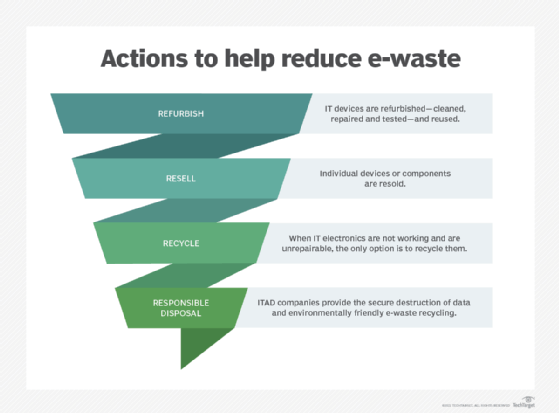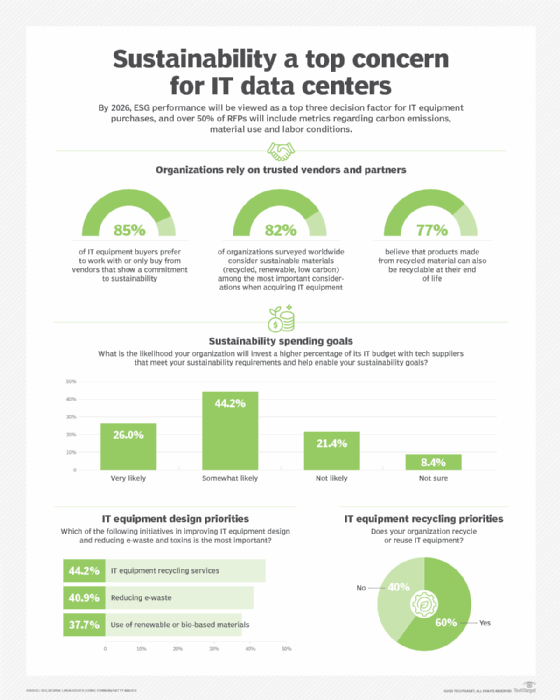
9 IT sustainability approaches to consider
Learn from these nine IT sustainability approaches and examples, including prioritizing e-waste reduction, using AI more responsibly and more.
More companies are prioritizing environmental issues, and IT has an important role to play.
That effort to support IT sustainability can also benefit the organization's competitive edge.
"Sustainability is not only the right thing to do, but it can help drive margin expansion within a company when it's done properly," said Randal Kenworthy, senior partner of the consumer and industrial products practice at West Monroe, an advisory firm headquartered in Chicago.
Reducing waste and inefficiencies can help make organizations greener, and these practices also drive costs down, he said.
"Sustainability shouldn't be viewed as a must-do because we have to meet some kind of corporate target," Kenworthy said. "You should be doing it also because it actually makes good business sense."
Here are nine sustainability approaches organizations should consider that can also enhance their competitive edge:
- Reduce e-waste and device environmental impact.
- Measure cloud-related carbon emissions.
- Practice green software development.
- Use sustainable UX principles.
- Adopt GreenOps.
- Use IT sustainability approaches as a business driver.
- Apply sustainability principles to AI.
- Make data center sustainability a priority.
- Remember to engage people.
Read on for a deeper dive.
1. Reduce e-waste and device environmental impact
IT emissions continue to grow as technology factors more heavily into all aspects of personal and work life. Data centers are a much discussed source of carbon emissions, but devices also have a profound environmental impact.
Laptops, tablets, smartphones and printers produce 1.5 to two times more carbon emissions than data centers, according to the September 2022 McKinsey & Company report "The green IT revolution: A blueprint for CIOs to combat climate change." This is, in part, because organizations not only have more user devices circulating among their workforces than on-premises data centers, but the refresh cycle for this technology is frequent.
On average, companies replace smartphones every two years, laptops every four years and printers every five, according to the report. On-premises servers, on the other hand, have a lifecycle of five years or more. What's especially concerning is that the carbon emissions generated by these devices are set to increase at a compound annual growth rate of 12.8% each year.
CIO and other IT leaders can take action to improve both device sourcing and usage to reduce their digital carbon footprint. Methods of greening device management include the following:
- Sourcing more energy-efficient technology.
- Increasing device lifecycles.
- Optimizing the number of organizational devices.
Deploying fewer devices, maximizing refresh cycles and taking actions such as reassigning older devices could reduce user device-related emissions by 50% to 60%, according to estimates in the McKinsey & Company report.
Sustainability requires solid IT asset management -- for example, having comprehensive inventory systems to understand what devices the company has.
"By having a better understanding of what's in your organization, you can better manage that and potentially extend the lifecycles of products," Kenworthy said.
Good IT asset management and extensive e-waste management are critical, according to Durgesh Patel, vice president of strategy and operations, global AI center of excellence at Hitachi. IT leaders need a sustainability strategy that encompasses what happens with laptops and other devices once they reach end of life.
"E-waste is also getting renewed attention -- not only from an environmental standpoint, but also due to the growing economic value of materials like rare earth elements," Patel added via email. "With global supply chains under pressure and new regulations emerging, especially in the EU and parts of Asia, this is quickly becoming a board-level topic in more regions."
In other words, reducing corporate e-waste is something every IT leader should prioritize.

2. Measure cloud-related carbon emissions
While moving to the cloud is not a one-action answer to sustainability problems, it's likely to factor into a greener strategy.
For example, selecting cloud service providers and hyperscalers that invest in greener practices, such as operating on renewable energy, can help address data center-related carbon emissions, according to the McKinsey & Company report. These organizations achieve a power usage effectiveness of 1.10 or less, while an average on-premises data center's PUE is 1.57. By migrating to a sustainability-focused cloud provider, organizations can reduce the carbon emissions produced by their data centers by more than 55%.
Before CIOs and IT leaders can reduce cloud-related emissions, they must have a clear idea of their current cloud footprint. This requires them to find ways to measure emissions so they can make informed decisions on where the problem areas are and how they can make improvements.
While the major cloud providers supply greenhouse gas emissions data, the collection methodologies aren't always clear, said Lisa McNally, global head of sustainability at Thoughtworks Inc., a consulting firm headquartered in Chicago.
Vendors have their own tools to calculate greenhouse gas emissions, but other tools exist, such as Thoughtworks' free open source Cloud Carbon Footprint tool that provides visualizations of estimated emissions from major vendors, such as AWS, Google and Microsoft. IT leaders should do their due diligence on which tool is most accurate and unbiased.
Once IT leaders calculate cloud emissions, they'll see there's a lot of opportunity for shifting workloads, McNally said. Understanding cloud emissions also brings clarity to IT leaders whose organizations use multiple vendors.
"They can actually make better tradeoff decisions by seeing where they sit across the different cloud providers in their usage," McNally said.
3. Practice green software development
Sustainable software development practices are an important but often overlooked area of green IT.
CIOs and IT leaders need to examine their organization's software development processes and how they may contribute to carbon emissions, said Marco Valtas, senior staff software engineer at GoFundMe, a for-profit crowdfunding platform headquartered in Redwood City, Calif. Organizations that develop applications for mobile phones require developers to keep energy efficiency top of mind, but many engineers don't take energy consumption into account.
"Bridging that gap so that [engineers] understand that the use of software will consume energy and that the production of energy emits carbon is one of the first cultural [changes] that you can [bring to] software development in general," Valtas said.
Organizations can also support their human engineers in adopting more sustainable software development practices, according to "GreenOps: Optimize Your IT Estate, Save Our Planet," published in 2023 by Capco, a global management and technology consultancy. The report advised organizations to let their engineers experiment with green software engineering, much like they would with other methods, such as secure coding. Organizations can also host hackathons to get people thinking about how to engineer greener software.
The Green Software Foundation (GSF) and GoCodeGreen both offer software-focused calculation tools and resources for green software engineering.
Additionally, GSF's Software Carbon Intensity standard details how to calculate the carbon emissions related to software.
4. Use sustainable UX principles
UX principles can support more sustainable IT. The principles of sustainable UX design widen beyond the focus on functionality and satisfaction to also help support environmental and social goals.
For example, one tenet of sustainable UX is a focus on minimalism and efficiency. For websites, bloated features are a no-no in terms of sustainability. Websites that are stuffed with features not only lead to user frustration, but they also require more data transfer and higher energy consumption -- and, in turn, higher carbon emissions. Similarly, lazy loading, where the website loads features as needed, is generally more sustainable than eager loading, which loads features all at once.
In general, sustainable UX focuses on a little less of everything or, to think of it another way, just enough to accomplish the goals versus offering up video, AI tools and the like when those aren't task-suited when something less resource-intensive could do the job better.
In terms of products, minimizing features and complexity, as well as designing for longevity and with a circular economy in mind, are important.
Sustainable UX even focuses on the ecosystem of sustainability -- for example, ensuring digital accessibility and inclusivity. A number of courses and toolkits are available for those who wish to learn more about sustainable UX, sustainable website design and sustainable product design.
5. Adopt GreenOps
A buzzword gaining some attention in IT circles is GreenOps.
It focuses on the many strategies and practices needed to decarbonize IT infrastructures.
CIOs and IT leaders should adopt a GreenOps framework to make sustainability-related decisions, Valtas said. Like FinOps, which guides organizations to make better investments based on hard data, GreenOps capitalizes on emissions data to drive critical sustainable IT decisions. Examples of its areas of concern include the following:
- The actual server capacity an organization might require versus overpurchasing capacity in cases where it might be required.
- What potentially greener regions a company might select for its cloud workflows -- for example, those areas that run on renewable energy.
- The time of day cloud workflows are the greenest due to what region they draw power from.
"It's basically applying not just a financial lens, but an emissions lens to that resource usage," Valtas said.
6. Use IT sustainability approaches as a business driver
That said, with the right metrics in place, CIOs and IT leaders can render their operations more sustainable.
CIOs and other IT leaders can take stock of energy use, emissions, waste generation and other environmental factors to then begin making decisions about sustainability that also support business goals.
Sustainability can provide cost savings, lower risk, support revenue growth and otherwise align with business initiatives.
7. Apply sustainability principles to AI
Many forms of AI have profound negative environmental impacts.
Researchers point to the negative environmental impact of generative AI, in particular, for its massive energy and water consumption and for its role in the demand surge for more data centers.
Its computational requirements for training, complex model support, vast amount of data generation and other requirements add to its negative environmental issues, all of which can be pushed aside as company leaders race to gain a competitive advantage with their own AI products.
For example, an average ChatGPT query uses 10 times the energy required of a typical Google query, according to "Electricity 2024: Analysis and forecast to 2026," published by the International Energy Agency.
The following suggestions are just a few of the practices meant to decrease negative environmental impacts of generative AI use, according to "IT sustainability at a crossroads," published by the IBM Institute for Business Value in 2024:
- Implement a documentation process that accounts for all code, models and training data. This provides visibility into an organization's generative AI development and use and facilitates the reuse of code and training data. It also helps companies to avoid unnecessary reduplication of AI models.
- Prioritize the use of energy-efficient AI models that don't need a lot of compute power to process data well.
- Use open source tools to upgrade existing generative AI models and to train them on new tasks. This is more energy-efficient than starting at square one each time an organization identifies a new use case for generative AI.
Companies can deploy pretrained AI and machine learning (ML) models instead of building their own, at least for use cases that are operational or do not differentiate the business, according to the "GreenOps" Capco paper. The paper noted that all the major cloud service providers have AI and ML models for images, text, natural language processing and video analysis.
8. Make data center sustainability a priority
Although data center sustainability is a complex topic with an array of issues, it's one of the most important for IT leaders to prioritize, especially with the greater reliance on AI.
Greening the data center involves a number of steps. These include the following:
- Turning to renewable energy where possible.
- Reducing energy consumption.
- Improving cooling systems.
- Using efficient waste management practices.

9. Remember to engage people
While the shift toward sustainable IT requires changing processes and technology, engaging employees in this effort is critical.
Sustainability awareness and training can support people in learning how to think about the environment as a required outcome or key component of whatever they're working on -- be it design, procurement or project management -- according to the Capco paper.
Sustainability still critical
IT has harmful environmental effects but can also support corporate environmental efforts, from driving efficiencies to solving environmental, social and governance (ESG) reporting challenges. Leaders must understand the plethora of IT sustainability approaches, as well as what works best for their organization. Either way, sustainability efforts are still critical.
Although ESG may have lost some prominence in executive boardrooms recently, sustainability remains a sound business strategy, Kenworthy added via email.
"Regardless of shifting political priorities, climate change isn't going away," he wrote. "Companies that ignore this reality do so at their own risk."
Patel had a similar take.
Fortune 500 companies haven't stepped away from sustainability efforts, despite some political pushback, Patel said via email. ESG goals, investor scrutiny and tightening global regulations continue to drive meaningful sustainability actions.
Carolyn Heinze is a Paris-based freelance writer. She covers several technology and business areas, including HR software and sustainability.







